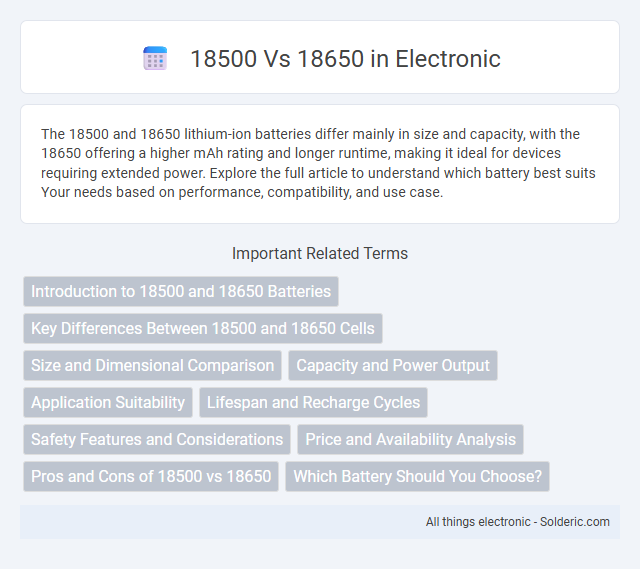The 18500 and 18650 lithium-ion batteries differ mainly in size and capacity, with the 18650 offering a higher mAh rating and longer runtime, making it ideal for devices requiring extended power. Explore the full article to understand which battery best suits Your needs based on performance, compatibility, and use case.
Comparison Table
| Feature | 18500 | 18650 |
|---|---|---|
| Dimensions (mm) | 18 x 50 | 18 x 65 |
| Capacity (mAh) | 800 - 1500 | 1800 - 3500+ |
| Common Use | Smaller flashlights, vape devices | High-performance flashlights, laptops, power tools |
| Voltage | 3.6 - 3.7V (Li-ion) | 3.6 - 3.7V (Li-ion) |
| Discharge Current | 5 - 15A | 10 - 30A+ |
| Weight (grams) | 40 - 50 | 45 - 70 |
| Availability | Less common | Widely available |
Introduction to 18500 and 18650 Batteries
18500 and 18650 batteries are lithium-ion cells commonly used in flashlights, laptops, and other portable electronics, with the numbers indicating their dimensions: 18mm diameter and 50mm length. The 18650 battery, slightly longer at 65mm, offers higher capacity and energy density compared to the more compact 18500. Both battery types support similar voltage outputs, typically around 3.6 to 3.7 volts, but the 18650 is favored for applications requiring longer runtime and higher current delivery.
Key Differences Between 18500 and 18650 Cells
18500 and 18650 lithium-ion cells differ primarily in size, with the 18500 measuring 18mm in diameter and 50mm in length, while the 18650 is slightly longer at 65mm. The 18650 typically offers higher capacity and longer runtime, ranging from 1800mAh to 3500mAh, compared to 18500 cells which usually provide 1200mAh to 1600mAh. Your device's compatibility and power requirements will determine which cell is more suitable based on these physical and performance differences.
Size and Dimensional Comparison
18500 and 18650 lithium-ion batteries differ primarily in size and dimensions, with the 18500 measuring approximately 18mm in diameter and 50mm in length, while the 18650 is slightly larger at 18mm in diameter and 65mm in length. This 15mm difference in length often affects compatibility with devices, as 18650 batteries offer more capacity but require more space. Manufacturers design battery compartments considering these dimensions, making it essential to choose the correct size for optimal fit and performance.
Capacity and Power Output
The 18650 battery typically offers higher capacity, ranging from 1800 to 3500mAh, compared to the 18500, which usually provides 1200 to 1500mAh, making the 18650 more suitable for longer usage periods. Power output also favors the 18650, supporting higher continuous discharge currents up to 30A or more, whereas the 18500 often delivers lower current output, generally below 10A. Your choice between these battery types should consider the balance of capacity and power needs for your device's performance requirements.
Application Suitability
18500 batteries, with their smaller size and slightly lower capacity, are ideal for compact devices like flashlights and portable electronics where space is limited. 18650 batteries, offering higher energy density and longer runtimes, suit power-hungry applications including laptops, electric vehicles, and high-performance torches. Selecting between 18500 and 18650 depends on balancing size constraints and power requirements of the specific device.
Lifespan and Recharge Cycles
The 18650 battery typically offers a longer lifespan and more recharge cycles compared to the 18500, often exceeding 500 cycles versus around 300-400 cycles for the 18500. This difference is due to the larger capacity and improved chemistry stability in 18650 cells, which handle repeated charging and discharging more efficiently. Choosing 18650 batteries enhances device longevity and reduces replacement frequency in high-drain applications.
Safety Features and Considerations
18500 batteries typically offer improved safety features compared to 18650 cells due to their smaller size and lower capacity, which reduces the risk of overheating and thermal runaway. Many 18500 cells include built-in protection circuits to prevent overcharging, short-circuiting, and over-discharge, enhancing overall user safety. When choosing between the two, consider your device's power requirements and ensure your battery selection aligns with the necessary safety precautions to protect your equipment and yourself.
Price and Availability Analysis
The 18650 lithium-ion battery is widely available and generally priced lower per unit due to mass production and extensive use in consumer electronics and electric vehicles. The 18500 battery, being less common and produced in smaller quantities, tends to have a higher market price and limited availability compared to the 18650 counterpart. Supply chain factors and demand volumes continue to drive the cost-effectiveness and accessibility of the 18650 battery over the 18500 model.
Pros and Cons of 18500 vs 18650
The 18500 battery offers a compact size, making it ideal for smaller devices, but it typically has a lower capacity and shorter runtime compared to the 18650. The 18650 is favored for its higher energy density, longer lifespan, and better performance in high-drain applications, though it is bulkier and may not fit in some compact devices. Your choice depends on whether you prioritize portability with moderate power or longer use and higher output for demanding electronics.
Which Battery Should You Choose?
The 18650 battery offers higher capacity and longer runtime, making it ideal for high-drain devices like laptops and power tools. In contrast, the 18500 battery is smaller and lighter, suitable for compact electronics where space is limited. Choosing between 18500 and 18650 depends on balancing device size constraints and required battery endurance.
18500 vs 18650 Infographic

 solderic.com
solderic.com